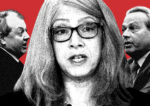 The Daily Dirt: Rent board protects high earners at developers’ expense
The Daily Dirt: Rent board protects high earners at developers’ expense
Trending
“Disturbing” drop in rent-stabilized profits in the Bronx
Landlords claim 2019 rent law wrecked their properties

From left: RGB Chair Nestor Davidson and CHIP’s Jay Martin (Getty, RGB, CHIP)
The Rent Guidelines Board’s annual pulse check on rent-stabilized buildings revealed a stark decline in the financial health of older properties with a high share of rent-stabilized units.
The findings, which draw on 2022 data, support landlord claims that revenue-restricted properties with higher expenses are getting “wrecked” by the 2019 rent law.
The report found the average net operating income — a profit measure that calculates revenue minus expenses, not counting debt service or reserve funds — slipped 7 percent annually in rent-stabilized properties built before 1974 outside of core Manhattan.
Here, core Manhattan is defined as south of West 110th Street and East 96th Street.
In the Bronx, the metric dropped by 18.5 percent, a “disturbing decline,” according to landlord group the Community Housing Improvement Program.
Meanwhile, in a true tale of two cities, profits for old buildings in core Manhattan surged by 42 percent, aided by rising rents for their free-market units.
Across the board, older buildings are often saddled with higher costs: pricier insurance premiums, more frequent maintenance issues and greater need for big-ticket investments such as a new boiler.
But older buildings with more units operating under the 2019 rent law, which severely restricted revenues for those apartments, are getting squeezed on both sides.
Outside of core Manhattan, where NOI for older properties fell by 7 percent, 61 percent of buildings are entirely rent-stabilized, RGB’s report found. By comparison, in core Manhattan where NOI rose significantly, just 16 percent of buildings are rent-stabilized.
The Bronx, which posted the city’s steepest NOI declines across older and newer buildings, is its own beast.
Nearly three-fourths of buildings in the borough are rent-stabilized, a revenue limitation by itself. But the borough also contains the only three neighborhoods citywide that reported declining rent collections in 2022: East Tremont and Belmont, Williamsbridge and Baychester, and Kingsbridge Heights.
All told, median rent collection grew 4.6 percent citywide and citywide excluding non-core Manhattan, compared to just 0.6 percent in the Bronx.
One Bronx landlord said while rent collection has always been an issue in the borough, it got worse during the pandemic as tenants protected by the eviction moratorium and by the Emergency Rental Assistance Program stopped paying rent.
“I still have applications pending,” the landlord said.
“Even if they approve them, they’ll only cover one year,” he added, referring to the program’s reimbursement limit. ERAP, launched in mid-2021, was designed to cover 12 months of pandemic arrears.
Many landlords feel the delays in housing court preclude them from pursuing eviction to demand repayment. One of the city’s largest landlords, the LeFrak Organization, recently sued the Office of Court Administration alleging “gridlock” in housing court and demanding a ban on court-manufactured delays.
On the expense side, Bronx landlords are also grappling with skyrocketing insurance costs, as carriers ditch the borough, buildings decay and claims surge.
Citywide, RGB’s report finds the share of “distressed” buildings in 2022 came in at just shy of 10 percent. The RGB defines distressed as operating and maintenance costs exceeding gross income.
The metric is lower than the 14 percent high recorded in 1990 when the RGB started tracking data. But it also represents a near-5-percentage-point surge from 2016’s low of 4.9 percent and the sixth straight year of increases.
“This data is from 2022,” CHIP executive director Jay Martin noted. “Things got worse in 2023.”
The RGB’s metric to define distressed properties also does not account for debt service, a growing problem for owners with interest rates having risen more than 500 basis points since March 2022. Refinancing in a higher-rate environment can be out of reach for landlords whose revenue is barely covering loan payments as is.
Read more
 The Daily Dirt: Rent board protects high earners at developers’ expense
The Daily Dirt: Rent board protects high earners at developers’ expense
 Rent-stabilized portfolio in contract for $180M — a 40% discount
Rent-stabilized portfolio in contract for $180M — a 40% discount
 Industry says report proves the 2019 rent law was “disastrous”
Industry says report proves the 2019 rent law was “disastrous”
The Bronx owner said his interest rate in February rolled over to 7.7 percent, plus principal payments.
“I have been in business a long, long time; I have never defaulted on a loan,” the landlord said. “This looks like it’ll be my first one.”
If you are a rent-stabilized landlord struggling to refinance, we want to hear from you. Email suzannah.cavanaugh@therealdeal.com.




